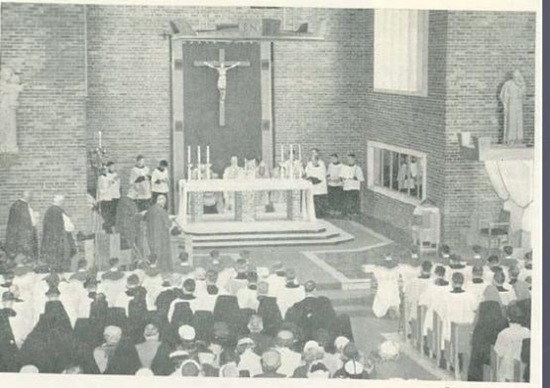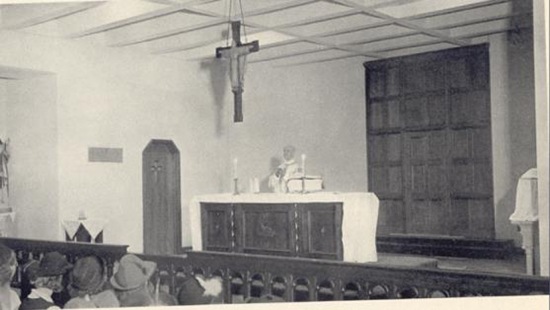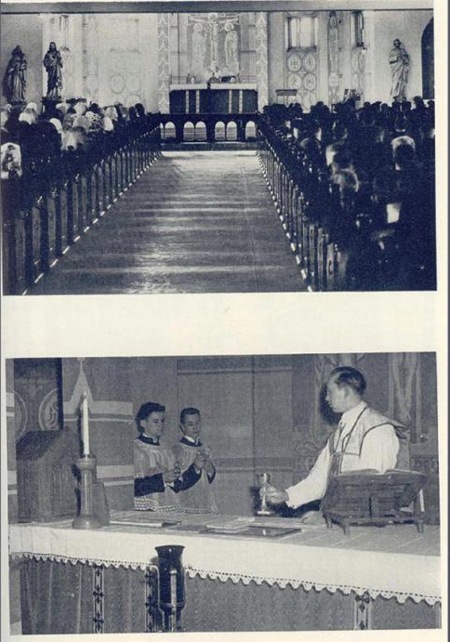Many have come to believe either than Vatican II changed the Roman Mass in a particular instant, in say 1965, or that Pope Paul VI's rite was imposed upon a liturgically pristine Church in 1969. This was not quite the case, although the changes most visible and dramatic to the laity did occur between 1964 and 1969.
Here are some photographs of the Roman rite in Transition.
The one immediately to the right shows the consistory of 1965, at which Paul VI created new cardinals for the Roman Church. The legendary Enrico Dante, the long time Master of Ceremonies for the Papal Court, was among those elevated. Readers will notice the odd practice of wearing a biretta with Mass vestments, something prelates typically only did at low Masses. The design of the vestments is stunningly bad, as though someone ripped the fabric from a 1950s American living room sofa, cut it in a conical shape, and draped it over the nearest priest. Still, the maniple survived through 1965 as an optional vestment. These designs had become popular in the United States and central Europe after World War I, but not throughout the entire Roman rite until Paul VI began using them after his election to the Petrine Chair. Why are they wearing Mass vestments? Surely there was no concelebration, outside of ordination ceremonies, before 1969! Oh yes there was!
This photograph is from a Mass at St. Peter's Basilica in May of 1969. The instructions given at the time demanded concelebration only involve a reasonable number of clergy, those who could fit around the altar. Paul VI expanded the altar and added a platform over St. Peter's tomb (still there) and conjoined a symmetrical table to the original. This is Mass according to a somewhat revised version of the Tridentine ordinary of the Mass. The new rite did not "kick in" until Advent that year. For a while each concelebrant got his own bread and chalice of wine to consecrate. By 1969 the rules reduced the number down to only what was in front of the main celebrant.
 |
| credit: St Bede Studio |
Some [very] daring priests even began to celebrate Mass facing the people, which required a relocation of the tabernacle. This was popular in some circles in post-World War I Europe and in post-World War II America, particularly on the east coast. Service time as chaplains during the war and the influence of Collegeville, Minnesota doubtlessly formed the tendencies of American clergy. Perhaps most startling is this: priests need permission and funding approval from their bishops to remodel their parishes. "Wreckovations" were more popular before 1969 than most think, and they were executed with episcopal approval.
 |
| Latin School in Indianapolis, 1965. Versus populum was common but not explicitly legal at this point. |
 |
| A Mass celebrated by Archbishop Howard of Portland, Oregon in 1947. |
Another in the same vein:
 |
| Archbishop O'Hara of Kansas City celebrated the Feast of Christ the King in 1954. |
 |
| An "offertory procession" of the President and First Lady of the Philippines in 1965. One can easily find similar images from New York City in the 1940s. credit: catholicphilippines.blogspot.com |
These practices did not appear out of thin air in 1969, or even in 1965. They had been on-going in many communities for decades by the time the Second Vatican Council and Paul VI popularized them.



The photograph of the Latin School in Indianapolis is actually Holy Rosary Church, currently home to the city's main "Extraordinary Form" Mass. (The long-closed Latin School occupied an adjacent building.) May I ask where that picture was published?
ReplyDeleteI do not know, I got it off of wikipedia.
DeleteNot surprised to hear the school struggled and closed. It was usually the nuttiest communities that suffered most after the Council.
A Mass celebrated by Archbishop Howard of Portland, Oregon in 1947.
ReplyDeleteIt isn't so bad and so untraditional. It reminds me of san'Clemente in Rome - It had to be versus populum because the East was at the entrance of the church, and because of the confessio below the altar.
Many basilicas in Rome in fact had the "versus populum"(which is in fact ad orientem geographicum) and the rubrics of the Old Missal stated that when the priest is facing the people he shouldn't turn around for the "Dominus vobiscum" &c. Are there any rubrics in the Old Missal which explicitly say that priest should face the liturgical East?
Right you are, Marko. I cannot think of any rubrics explicitly demanding ad orientem worship, it was simply the assumed norm. A rubric from the offertory of the 1962 Missal reads "Postea osculatur altare et, versus ad populum, extendens et iungens manus, voce paululum elevata, dicit...." Nothing comes my my mind mentioning geography.
ReplyDeleteThere are probably a dozen or so churches in Rome where versus populum is also ad orientem, including the four papal basilicas.
The arrangement you highlighted is not so bad, whereas the next one is clearly done in the spirit of innovation, without even the episcopal throne in the apse. I should note that on closer inspection that Portland Mass appears to be Mass in the Presence of a Bishop." The bishop is wearing cope and mitre while someone else is at the altar with a chalice, I am guessing it is the priest performing ablutions.
Nevertheless, rubrics presuppose that the altar is ad orientem because they instruct the priest to turn around to face the people. The ad orientem-versus populum is an exception.
DeleteMarko, that was my point. That rubric would not mention "versus populum" were the priest not already facing the people.
ReplyDeleteSomething I find interesting is that in most places where building an eastward altar would have resulted in a Roman basilica-like arrangement, people opted for altars facing West and called it "Liturgical East." St. Aloysius and Blackfriars in Oxford are immediate examples from my personal memory, and I am sure there are many others.
That should be "were the priest already facing...."
DeleteYes. And i agree with that.
DeleteLiturgical East is more important than geographical one. Also, when looked from mere human perspective, it really becomes irrelevant which way the geographical East is, since many people(especially women) can't orient in closed spaces.
But if building a church with sanctuary facing East is possible, i would certainly commend it. My parish church(although it is of newer build) is, whether on purpose or by accident, oriented that way - sanctuary is facing East.